Dynamics of Kiteboarding in the Outer Banks


Intro
The Outer Banks stands as a shining jewel on the map of kiteboarding, drawing enthusiasts from all walks of life. This region, characterized by its spacious beaches and consistent winds, creates a playground where water meets wind. Each year, kiteboarders flock to these sandy shores, eager to harness the elements, and experience the thrill of gliding across the waves with nothing but a board and a kite.
The beauty of kiteboarding in the Outer Banks isn’t just in the sport itself but in the surrounding community and lifestyle. Here, locals and visitors alike blend seamlessly, sharing tips and tales from the water, transforming an exhilarating sport into a vibrant social experience.
As we dive deeper into the nitty-gritty, this article will unfold essential elements of kiteboarding. We will pinpoint the must-have gear and equipment, explore techniques suited for everyone from beginners to the seasoned pros, and provide insights on cultural hotspots that enrich the kiteboarding experience in this coastal wonderland.
Whether you're an aspiring kiteboarder dreaming of your first ride or a skilled rider eager to master new tricks, this comprehensive guide will serve as a valuable resource. Prepare to navigate through the exhilarating currents of knowledge on the kiteboarding scene in the Outer Banks, as we embark on this exploration together.
Prelude to Outer Banks Kiteboarding
In the world of water sports, few activities offer the sheer thrill and exhilaration that kiteboarding does. Nestled along the North Carolina coastline, the Outer Banks has become a prime destination for enthusiasts of this vibrant sport. This stretch of land is not just a pretty backdrop; it provides a unique combination of geography and climate that truly enhances the kiteboarding experience.
Understanding kiteboarding in the Outer Banks involves grasping the importance of its environment, which influences everything from wind patterns to water conditions. The coastal features here invite both beginners and seasoned riders to engage with the waves and winds in a way that’s unparalleled. The accessibility of various spots makes it a go-to for both locals and travelers alike, fostering a sense of community among those who share the passion for gliding over water while harnessing the wind.
Key Elements of the Outer Banks Kiteboarding Scene
- Ideal Conditions: The Outer Banks is famous for its reliable wind and varied water conditions, appealing to all skill levels.
- Diverse Locations: Each spot offers different landscapes, from shallow flats to open ocean, providing options for every rider’s preference.
- Community Engagement: With numerous kiteboarding schools and clubs, new riders have ample opportunities to learn and connect.
Moreover, with the right guidance, learning the ropes of kiteboarding can be exhilarating, and mastering it can lead to a lifelong passion. The importance of proper training and knowledge about safety cannot be stressed enough. As the saying goes, "It takes a village," and in kiteboarding, the local instructors and fellow enthusiasts create an atmosphere that is both supportive and encouraging.
The cultural aspects surrounding kiteboarding in the Outer Banks also add richness to the sport. Events, competitions, and community gatherings not only showcase talents but also foster friendships that often extend beyond the sport itself. This blend of skills, camaraderie, and natural beauty creates an inviting space for everyone eager to ride the winds.
As we dive deeper into the various facets of kiteboarding in this region, it becomes clear that the Outer Banks isn't merely a destination—it's a culture. Whether we discuss the geographical features that make it a hotspot or the practical techniques for newcomers, understanding these dynamics is crucial for anyone interested in exploring this vibrant sport.
Geography and Climate of the Outer Banks
Understanding the geography and climate of the Outer Banks is essential for anyone looking to engage in kiteboarding. This unique region, situated along the coast of North Carolina, is renowned for its breathtaking landscapes and favorable weather patterns. From the soft, sandy beaches to the windswept dunes, these physical features frame an ideal environment for kiteboarding enthusiasts, making it a premier destination.
Unique Coastal Features
The Outer Banks showcase a collection of coastal traits that significantly influence kiteboarding experiences.
- Barrier Islands: The Outer Banks consist of a series of barrier islands, creating tranquil bays and choppy ocean waters that provide diverse kiteboarding conditions. This setup allows riders to choose spots that align with their skill levels and desired riding styles.
- Sand Dunes: Towering sand dunes like those in Jockey's Ridge State Park act as wind breaks and can create unique wind currents that kiteboarders must navigate. These natural formations offer fun slopes for those looking to practice jumping and tricks.
- Shallow Waters: The shallow waters around the islands facilitate a safer learning environment for novices. Riders can easily find their footing without the fear of deep water since many areas host calm lagoons and estuaries.
These features not only enhance the sport but also attract a variety of visitors eager to explore the coastal landscape.
Wind Patterns and Weather Considerations
Wind is undoubtedly the lifeblood of kiteboarding. In the Outer Banks, the geography influences wind patterns in ways that make it favorable for riders:
- Prevailing Winds: The region benefits from consistent southeast winds, with summer months witnessing stronger and more reliable gusts that last throughout the day. Understanding how to read these winds can lead to successful sessions for kiteboarders.
- Seasonal Variability: Fall often brings more stable winds, while springtime may present shifting conditions. Enthusiasts should keep potential weather changes in mind, as unpredictable winds can occasionally make conditions challenging.
- Stormy Weather: While bouts of inclement weather can occasionally disrupt activities, they also contribute to some of the most exhilarating riding experiences. Kiteboarders should always check forecasts thoroughly via resources like NOAA (www.noaa.gov) to stay ahead of any storms.
Being aware of local rules, like the recommendation to avoid riding during thunderstorm conditions, can ensure safety amidst these unpredictable weather patterns.
Seasonal Variations in Conditions
The seasons in the Outer Banks breathe life into the kiteboarding landscape, each bringing something distinct:
- Summer: Warm temperatures and steady winds make this the peak season for kiteboarding. Clear skies and high air pressure often lead to excellent visibility for riders, while the water stays pleasantly warm.
- Fall: With the peak tourist season winding down, autumn offers crisp weather and moderate winds. The shifting foliage paints a vibrant backdrop as riders find fewer crowds on the beaches.
- Winter: For the brave-hearted kiteboarders, winter can provide unique challenges with its cold temperatures and brisk winds. However, those willing to brave the chill might find some of the most pristine conditions.
- Spring: As the snow melts and temperatures rise, spring heralds consistent breezes and blossoming landscapes. It's also a great time for kiteboarding beginners to hit the water with manageable conditions.
Adapting one's kiteboarding strategy based on the seasonal dynamics can greatly enhance the overall experience and safety of riders navigating the Outer Banks.
"For kiteboarders, it’s not just about riding the waves, it’s about understanding the symphony of nature that allows them to dance across the water."
This nuanced understanding of geography and climate makes the Outer Banks not just a destination, but a living lesson on how elements intertwine to create an ideal environment for kiteboarding.
Understanding the Basics of Kiteboarding
Kiteboarding is an invigorating sport that combines elements of surfing, windsurfing, and paragliding. Grasping the fundamentals of this sport is crucial, especially for those keen on experiencing the thrill of gliding across the water while being propelled by a powerful kite. For newcomers to kiteboarding, understanding the basics lays a solid foundation, enhancing not only safety but also the enjoyment of the sport.
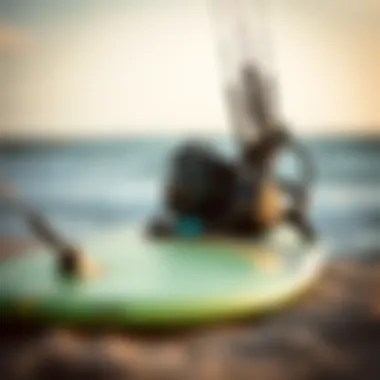
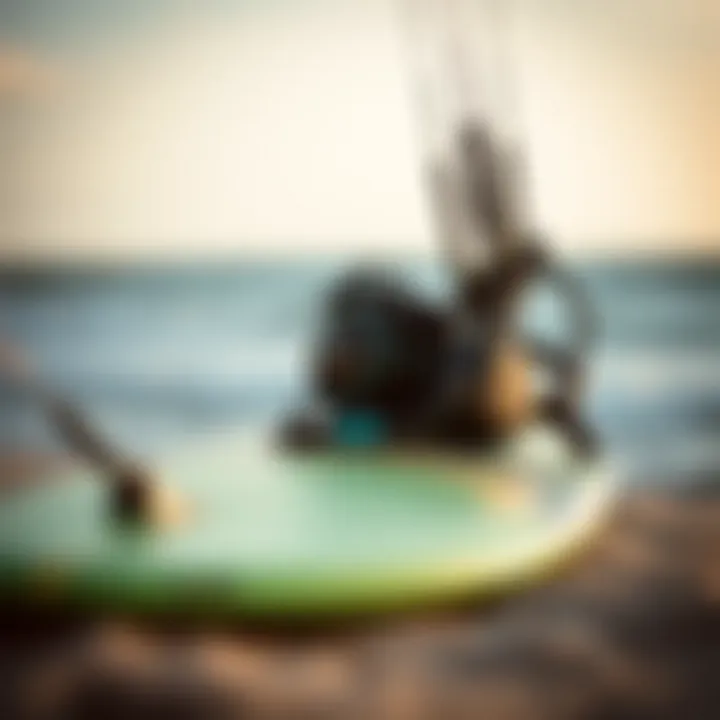
Equipment Overview
Before diving into the water, a kiteboarder must familiarize themselves with essential equipment. Here’s a concise list of the main components:
- Kite: The heart of the operation, kites come in different shapes and sizes. The right kite depends on the rider’s weight, wind conditions, and skill level. For example, a larger kite catches more wind, providing more lift but may be harder to control for beginners.
- Board: Similar to a surfboard, kiteboards vary in size and shape, affecting maneuverability and speed. Some boards are designed for flat water, while others are better suited for waves.
- Harness: This device connects the rider to the kite via a safety line. It allows for less muscle strain, enabling the kiteboarder to focus on balance and control.
- Lines: Made of strong, lightweight materials, lines connect the kite to the harness and are crucial for kite control.
- Safety Gear: A helmet and impact vest are suggested to protect against falls and mishaps.
Investing in quality gear is paramount. Buying from reputable manufacturers helps ensure that the equipment can endure the rigors of the sport and maximize safety.
Kiteboarding Terminology Explained
Understanding the jargon of kiteboarding can be daunting for newcomers. Familiarizing oneself with common terms paves the way for better communication and learning. Here are some key phrases:
- Depower: The ability to adjust the kite’s power by changing its angle to the wind. This is essential for maintaining control in varying conditions.
- Upwind: Refers to the direction from which the wind is coming. Mastering the skill to ride upwind is crucial for any kiteboarder.
- Downwind: The direction the wind is blowing towards. Riding downwind often allows for more speed and fun, but it's important to know your surroundings.
- Relaunch: Refers to getting a kite back into the air after it has landed on the water.
- Trimming: Adjusting the lines to change how the kite flies, which affects speed and control.
Learning kiteboarding’s vocabulary opens doors to deeper understanding. Knowing the terms can enhance instruction and increase confidence when on the water.
Overall, a firm grasp of the basics of kiteboarding is invaluable. It prepares enthusiasts for more advanced skills and allows them to navigate the local scenery of the Outer Banks with flair and finesse. As they progress, riders can discover their own unique style and contribute to the vibrant kiteboarding community.
Getting Started with Kiteboarding
Beginning any new adventure can be both thrilling and daunting, and kiteboarding is no exception. The Outer Banks, with its ideal conditions and beautiful landscapes, offers a playground for both novices and experienced riders. Understanding the essentials of kiteboarding is critical to ensure both enjoyment and safety.
This section delves into key elements that will pave the way for a successful kiteboarding journey, including the critical gear you’ll need, vital safety tips to keep in mind, and how to find the right instruction tailored for your skills.
Essential Gear for Beginners
Before you hit the water, having the right equipment is paramount. The first step is to choose a proper kite. Look for something that is beginner-friendly; often manufacturers label their kites for different skill levels. A typical beginner kite is large enough to catch wind but not so big that it becomes unwieldy.
Key gear includes:
- Kite: Look for options such as the Liquid Force Kite or North Kiteboarding’s range that are known for their stability and ease of control.
- Bar and Lines: This connects you to the kite. Ensure they’re robust and intuitive to use.
- Harness: A good harness will help you distribute the kite's pull across your body, making it easier to control.
- Board: Start with a larger board; it offers more stability and is easier to ride.
- Safety Gear: Helmet and impact vest are often overlooked but can protect you from injuries.
Investing in quality gear will pay off in comfort and safety, which can make all the difference in your learning curve.
Safety Considerations
Safety in kiteboarding can’t be emphasized enough. It's easy to get caught up in the excitement, but being aware of your surroundings and understanding potential hazards can save lives.
- Always wear a helmet and impact vest, regardless of your skill level.
- Stay aware of the wind direction and strength. Do not underestimate changing weather conditions; they can affect your control over the kite.
- Know your surroundings. Avoid crowded areas and keep a safe distance from other water users.
- Learn the proper launch and land techniques. This reduces the risk of injury to yourself and bystanders.
Remember: When in doubt, do not go out. Taking a moment to evaluate conditions can save you from struggles and even accidents on the water.
Finding the Right Instruction
Navigating the world of kiteboarding without proper training is like setting sail without a map; it can be done, but it’s often fraught with challenges. Look for certified instructors who have a solid reputation. They tend to blend teaching with safety seamlessly, preparing you for what lies ahead.
A good instructor will:
- Provide tailored lessons based on your skill level. Whether you're just starting or have some experience, customized instruction is vital.
- Ensure that you grasp safety protocols, which should always be the priority.
- Share local knowledge about the specific spots in the Outer Banks, including ideal launch sites and potential hazards.
Ultimately, investing time in high-quality instruction can accelerate your learning curve and enhance your overall enjoyment of kiteboarding.
By arming yourself with the right equipment, understanding the necessary safety practices, and securing the appropriate instruction, you set the stage for thrilling sessions on the water. The Outer Banks awaits—now it’s your turn to dive in!
Techniques for Mastery
Understanding various techniques in kiteboarding is essential for anyone looking to improve their game in the Outer Banks. Mastery of these techniques does not only enhance performance but also builds confidence on the water. Kiteboarding, at its core, is a fusion of skills and style; thus, honing these techniques can lead to more thrilling experiences. The dynamic nature of kiteboarding demands adaptability and resilience, which fit perfectly into the unpredictable waters and winds of the Outer Banks. Let’s break down the essential techniques that every kiteboarder should grasp.
Fundamental Skills for Beginners
For beginners, grasping the fundamental skills is like laying the groundwork for a sturdy house; it must be solid. Some of the key skills include:
- Kite Control: Learning to control the kite in the air is paramount. Beginners often struggle with this, but practicing power strokes can make a big difference.
- Body Positioning: Your stance on the board impacts balance significantly. Keeping your knees slightly bent and weight centered will help maintain control.
- Launching and Landing: Proper techniques for launching the kite and landing safely are vital. This involves clear communication with your board support.
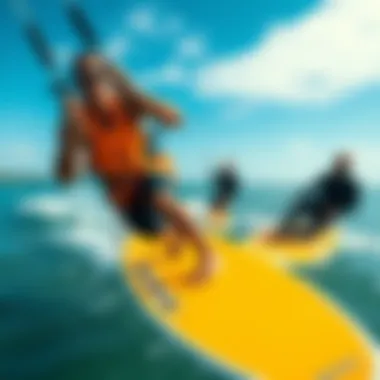
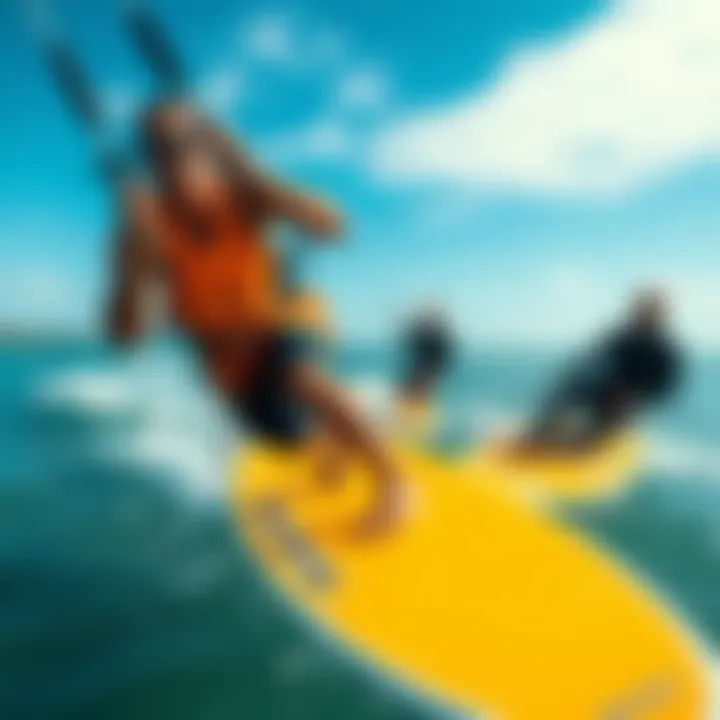
Mastering these skills feeds into a more enjoyable experience. It’s akin to learning to walk before running. Start slow, and don’t be shy about seeking help or taking lessons.
Intermediate Techniques to Enhance Performance
Once you've got the basics nailed down, it’s time to elevate your game with intermediate techniques. Consider:
- Jumping: This technique adds a spark to your kiteboarding. To jump higher, practice edging hard against the kite while pulling up with your back hand.
- Transitions: Mastering the art of transitions—shifting your direction without losing momentum—keeps you moving fluidly and building your confidence.
- Riding Switch: Riding switch means that a rider adopts the opposite stance than what they are accustomed to. It enhances balance and can make you a more versatile rider.
These techniques broaden your skillset and make you more adaptable on varying conditions, which comes in handy in the Outer Banks.
Advanced Maneuvers for Experienced Riders
For the seasoned rider, advanced maneuvers can turn a ride into an electrifying experience. Some techniques to master include:
- Handle Passes: A handle pass involves letting go of the control bar and catching it again before landing. This trick demands precise timing and body control.
- Kiteloops: This maneuver involves looping the kite aggressively in the air while managing the tension on the lines; it’s thrilling and requires practice.
- Mobes: A very advanced move that can put you on the map in the kiteboarding community. It combines a rotation with a handle pass.
These advanced maneuvers require a solid foundation of skills and should only be attempted once you feel comfortable and capable in your abilities.
"In kiteboarding, your progression is only limited by your willingness to try new things and learn from every wipeout!"
As kiteboarding evolves, the sport continually challenges riders at every level.
Kiteboarding techniques are not just about performing tricks; they embody the spirit of the sport. So, practice, observe, and learn from others, and never lose sight of the joy that comes with each ride in the Outer Banks.
Navigating Outer Banks Kiteboarding Spots
Navigating the famed kiteboarding spots of the Outer Banks is crucial for several reasons. First and foremost, it helps enthusiasts find the optimal locations that cater to their skill levels and preferences. Each spot has its unique features and conditions, which makes it essential for practitioners to understand where to take their boards for different weather scenarios and wind patterns. Moreover, being well-informed enables kiteboarders to enjoy a safer, more fulfilling experience, while also respecting the local environment and community.
Popular Locations and Their Features
When it comes to kiteboarding in the Outer Banks, you might say it’s like finding a needle in a haystack, given the array of options available. Here are some of the standout spots:
- Cape Hatteras National Seashore: This area is often considered a mecca for kiteboarders. The broad and shallow waters offer ideal conditions for both beginners and experienced riders. The wind here is relatively consistent, providing great sessions throughout the day.
- Fountain of Youth: Hidden away slightly, this location offers beautiful scenery and epic conditions for kiteboarding. The waters are often calm, making it a great choice for those just starting out.
- Ocracoke Island: Known for its picturesque views, Ocracoke has spots that challenge even the most seasoned kiteboarders. The waves here can be exhilarating, but the scenery makes up for any struggle.
- Kiteboarding on Sound Side: The Pamlico Sound's flat waters serve up a different experience. Riders can enjoy long runs and practice their tricks in a pretty safe setting.
Beyond these popular areas, local riders often share their tips about lesser-known spots that provide unique experiences, catering to those looking to escape the crowds.
Local Regulations and Etiquette
Understanding local regulations and etiquette is just as important as mastering your kiteboarding skills. Adhering to these guidelines not only ensures that all participants have a good time but also fosters a sense of community and respect among enthusiasts.
- Kiteboarding Zones: Be aware of designated kiteboarding areas. Some spots may have restrictions, so it’s wise to do some research or ask a local before you hit the water.
- Respecting Wildlife: The Outer Banks are home to diverse ecosystems. Make sure to keep your distance from nesting birds and marine life. This preserves the natural beauty and supports local wildlife.
- Launching and Landing: Familiarize yourself with proper launching and landing protocols. Always ask for permission if you're launching near other kiteboarders.
- Kiteboarding Etiquette: It’s essential to follow the right of way rules. If you're unsure, consult with fellow kiteboarders or local instructors who can provide insight.
By following these guidelines and embracing the sense of community, kiteboarders can contribute to a more enjoyable and sustainable environment for everyone involved.
Bottom line: Familiarity with local regulations and respect for fellow riders can significantly enhance your kiteboarding experience in the Outer Banks.
The Cultural Aspect of Kiteboarding
In the sprawling landscape of the Outer Banks, kiteboarding is more than just a sport; it's a culture. The act of gliding over the water, pulled by a powerful kite, creates an exhilarating tapestry woven with camaraderie, passion, and an appreciation for the natural world. Understanding the cultural aspect of kiteboarding reveals how this community thrives in the windy breezes of the Outer Banks, evolving through shared experiences and collective learning.
One significant element of the kiteboarding culture is the sense of community. Riders often bond over their mutual love for the sport, forming friendships that extend beyond the water. Whether it’s sharing stories of incredible feats or offering tips on improvements, the connections formed among kiteboarders foster a sense of belonging. Newcomers are welcomed with open arms, and this culture of inclusivity grows even stronger as more enthusiasts flock to the area, breaking ice and forging relationships from the get-go.
The social aspect is another noteworthy element. Kiteboarding spots become lively meeting places where people gather to share not just their expertise on the waves but also from life beyond the board. Conversations stretch from technique discussions to planning the next big adventure or sharing local secrets. Consequently, the community thrives with an infectious enthusiasm, where metaphorical high-fives are just as crucial as actual ones.
"Kiteboarding is truly a thrilling blend of sport and social interaction. It’s powerful to see how a shared passion can transform a group of strangers into a tight-knit community."
Community Building Among Kiteboarders
The journey into the kiteboarding lifestyle is often paved by the friendships forged along the way. Established riders often serve as mentors for beginners, providing guidance on everything from basic maneuvers to the intricacies of equipment maintenance. These interactions foster an environment of learning, where insights are freely exchanged, and everyone benefits.
Many kiteboarding communities organize group sessions and workshops to improve skills together. Even informal gatherings, like weekend riding meet-ups, contribute to a robust network of support. This spirit of collaboration not only enhances everyone’s skills but also solidifies friendships.
Unquestionably, the cultural fabric of kiteboarding thrives on local events. Surf shops and schools frequently host outings that amplify community interaction. These outings help solidify social bonds further, encouraging a sense of local pride as riders share their unique stories tied to the Outer Banks.

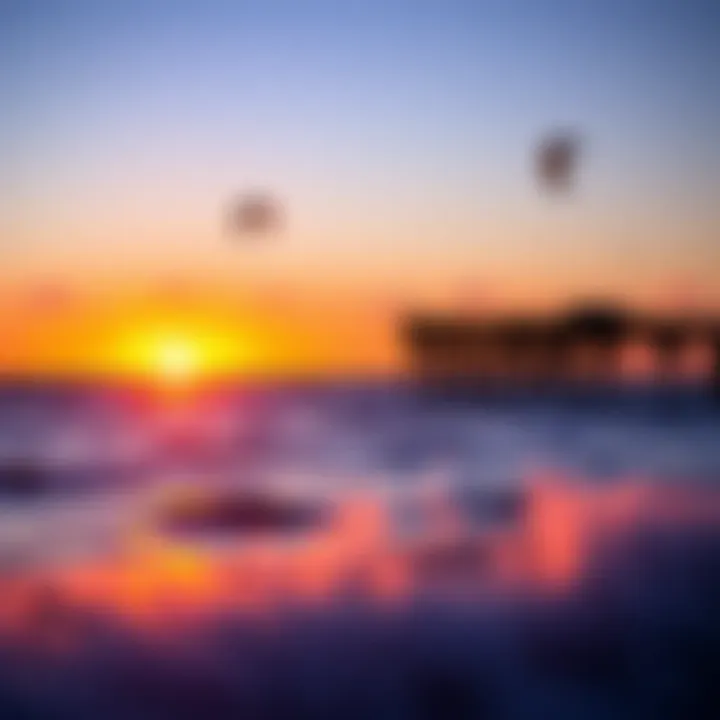
Events and Competitions in the Outer Banks
Kiteboarding competitions in the Outer Banks are quite the spectacle. These events draw participants and spectators from all walks of life, creating an electrifying atmosphere. Whether it’s a casual gathering on the beach or a well-organized competition, the energy is palpable.
Local and regional kiteboarding contests serve not only as a platform for riders to showcase incredible skills but also to unite the community. Events like the OBX Kiteboarding Festival provide an excellent opportunity for kiteboarders to compete while connecting with others. These competitions often feature categories for various skill levels, making them inclusive for both seasoned pros and novices eager to test their mettle.
Moreover, these gatherings often include live music, food vendors, and workshops, transforming a simple competition into a full-fledged community celebration. Engaging local businesses further integrates the kiteboarding culture into the fabric of the Outer Banks. Participants are encouraged to mingle, network, and create lasting memories beyond just the rides, making every event a stepping stone towards strengthening the local kiteboarding community.
Kiteboarding in the Outer Banks exemplifies how a sport can transcend individual enjoyment, becoming a communal experience. The culture thrives on the connections formed, the shared knowledge, and the events that bring everyone together, making it a true reflection of the spirit of the Outer Banks.
For more insights and event updates, check platforms like Reddit and Facebook, connecting riders across the globe.
Sustainability in Kiteboarding
As kiteboarding grows in popularity around the world, understanding its sustainability becomes crucial. Not just to protect the breathtaking locations where enthusiasts gather, but also for the long-term viability of kiteboarding itself. The Outer Banks, known for its vibrant ecosystems, face challenges that require kiteboarders to be mindful of their impact. This section sheds light on the pressing need for sustainable practices and highlights several key considerations that kiteboarding participants should take into account.
Impact on Local Ecosystems
Kiteboarding in the Outer Banks can activate a variety of environmental concerns. The highly sensitive coastal ecosystems can be adversely affected by increased foot traffic, noise, and equipment disposal. For instance, shorebirds often nest in the sandy areas where kiteboarders launch their gear. If these areas are disturbed, it can lead to significant declines in local bird populations. Moreover, the native flora can suffer when equipment is dropped or left behind, potentially allowing invasive species to take root.
Educating riders about local wildlife and the importance of preserving these natural habitats is vital. For example, following designated paths between launch sites and the water reduces harm to native plant life. Embracing this knowledge and responsibility fosters a healthier relationship between the sport and its surroundings.
Promoting Responsible Practices
To mitigate impact, kiteboarders must adopt sustainable practices that support environmental stewardship. Here’s a guide for promoting responsibility in the sport:
- Gear Responsibly: Use eco-friendly materials when choosing equipment where possible. Some brands are now manufacturing gear from recycled materials, and opting for these can lessen our footprint.
- Leave No Trace: Always pack out what you bring in. Take any trash, including broken or worn-out kite parts, back with you to ensure the pristine beauty of the Outer Banks remains intact.
- Stay Informed: Participate in local cleanup efforts or community workshops that focus on environmental education. Being aware of the local ecology and conservation efforts creates a deeper connection to the sport and the environment.
- Follow Guidelines: Each kiteboarding spot might have specific rules or regulations in place. Familiarize yourself with these to reduce harm and promote sustainable enjoyment of these beautiful locations.
"If you love the sport, you gotta love the planet. It's the only one we got to ride on!"
Promoting sustainability isn't just a responsibility; it enhances the kiteboarding experience. Thriving ecosystems lead to better conditions for the sport, ensuring that future generations can enjoy the unique charm of the Outer Banks. By being thoughtful of our footprint and the treasure that is our natural surroundings, we contribute to the longevity of both kiteboarding and the vibrant ecosystems it thrives in. In essence, safeguard the adventure; cherish the environment.
Gear Maintenance and Care
Caring for kiteboarding gear is not just a chore; it’s a crucial aspect of being a responsible and savvy kiteboarder. Just like a race car driver wouldn’t let their vehicle spin wheels without regular check-ups, you need to keep your gear in tip-top shape to enjoy kiteboarding to the fullest. Maintenance can extend your equipment's lifespan, ensure safety, and enhance performance on the water.
Why It Matters
Proper maintenance prevents unexpected mishaps that can lead to accidents. One overlooked tether could mean the difference between a smooth ride and a crash landing. Moreover, caring for your gear can save you hefty costs in replacements. It’s an investment in both your safety and your riding experience.
"A stitch in time saves nine."
With that in mind, let’s get into the nitty-gritty of how to keep your gear sailing smoothly.
Routine Maintenance Checks
Keeping up with regular checks can make a world of difference. Here are some important areas you should inspect:
- Kite Fabric: Look for any rips or wear on the fabric. If you notice a tear, know how to do a simple patch job or consult a pro.
- Lines and Tethers: Check them for frays or knots. A single weak line can compromise the integrity of your entire setup.
- Bar and Control System: Ensure your handles and clips are functioning properly. Any debris can cause them to malfunction, which is a safety hazard.
- Board condition: Look for dings or water buildup. Make sure the fins are firmly attached too.
Storing Equipment Properly
When the sun sets on a great day of kiteboarding, how you store your gear can make all the difference. Improper storage can cause premature wear, leading to costly repairs and replacements down the line. Here are tips:
- Dry Everything: Water can cause mold and can corrode parts. Make sure everything is dry before packing up your kite, lines, and board.
- Avoid Heat and UV: Store your gear in a cool, shaded area. Extreme temperatures and sunlight can degrade the materials over time.
- Use Gear Bags: Invest in good-quality bags for your kite and board. It keeps them protected from dust and dings while in storage.
- Keep It Organized: Always store your gear in a designated area. This will help you quickly check for any missing items before your next session.
By following these maintenance tips and making gear care a regular part of your routine, you can spend more time enjoying the thrill of kiteboarding instead of worrying about your equipment. Your future self will thank you!
The End
The significance of the conclusion in this article cannot be overstated. It serves as a vital summary of the insights and discussions outlined throughout the exploration of kiteboarding in the Outer Banks. By reflecting on crucial elements such as the geographic advantages, safety protocols, and community spirit of the kiteboarding culture, the conclusion ties together the various threads woven into the narrative.
A point worth emphasizing is that kiteboarding is not merely a sport but a harmonious blend of skill, nature, and community engagement. As enthusiasts navigate the waters of the Outer Banks, they become part of a broader ecosystem that thrives on shared passion and respect for the environment. Recognizing this interconnectedness enhances one’s appreciation of both the sport and the natural world.
Furthermore, seasoned riders and newcomers alike can find hope and motivation in the comprehensive techniques and practical tips discussed. Whether it's mastering the fundamentals or gearing up for competitors, kiteboarding offers endless opportunities for growth and enjoyment. As kiteboarders journey through various weather patterns and local spot regulations, staying informed is key to a rewarding experience.
In summary, this article not only serves as an informative guide but aims to inspire. Kiteboarding in the Outer Banks is a pursuit that welcomes all—those who chase the wind and ride the waves will find a rich community and a rewarding adventure.
"The sea is a place of freedom where every kiteboarder finds their spirit."
Ultimately, understanding the dynamics of Outer Banks kiteboarding allows individuals to engage more thoughtfully with the sport, ensuring sustainability and camaraderie endure for generations to come. For more information, check out resources like Wikipedia, Encyclopedia Britannica, and community discussions on Reddit to deepen your insight into this exhilarating activity.







